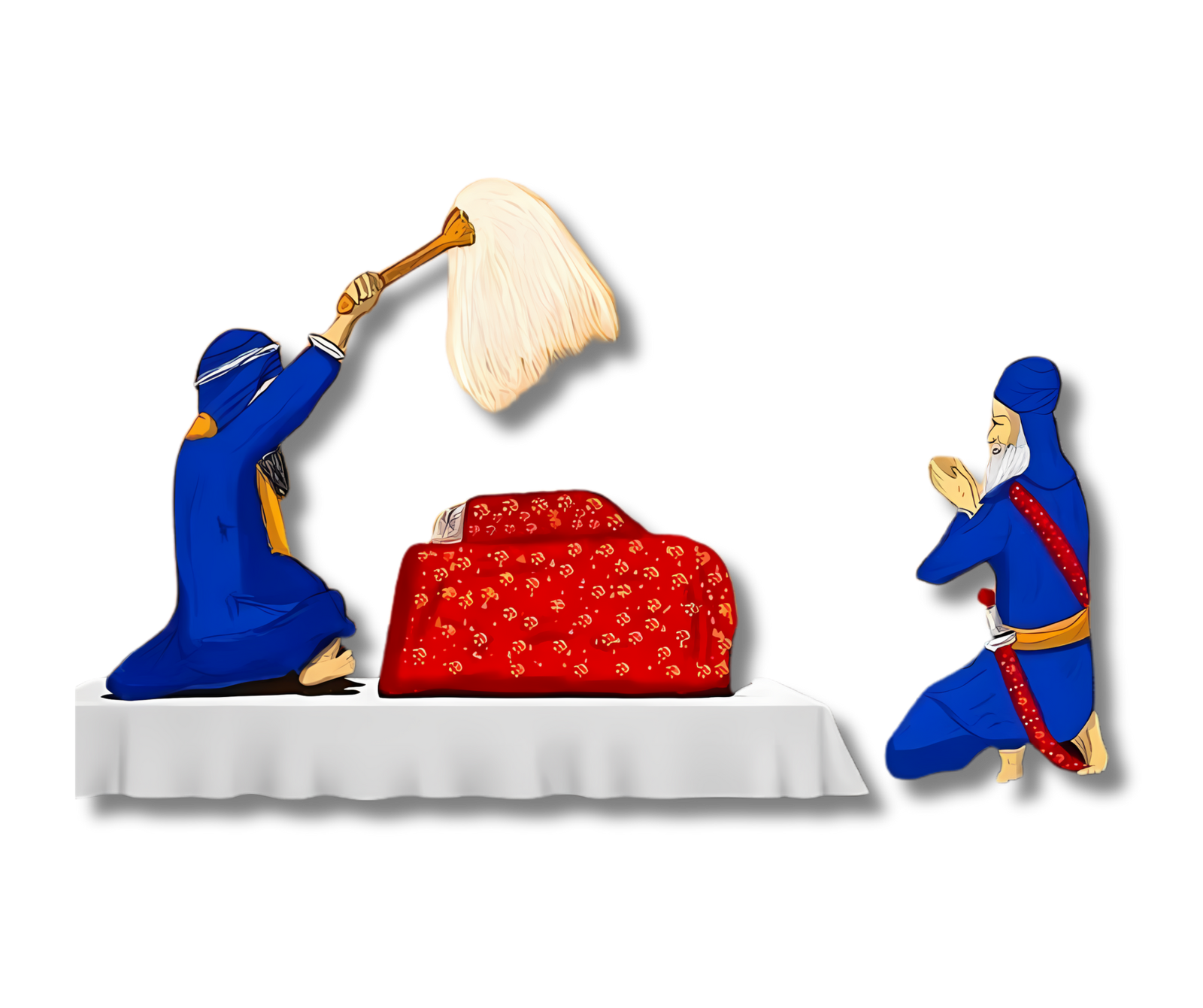ਸਤਿਗੁਰੁ ਜਾਗਤਾ ਹੈ ਦੇਉ ॥੧॥ ਰਹਾਉ ॥
Our Commitment to Revering Gurbani
The Gurus, in their ten sacred forms, demonstrated profound respect, love, and reverence for Gurbani. Following in the footsteps of Satguru Jee, we must continue to honor Gurbani with utmost devotion. Adhering to specific guidelines ensures we maintain the sanctity of Gurbani:
- Prior to sitting on Guru Jee’s Tabiya (platform), one must bathe and wash their feet to ensure cleanliness.
- In instances of impurity, it is essential to wash one's hair, don fresh attire, recite Jap Jee Sahib, and perform Ardaas before approaching the Tabiya.
- Avoid touching Sri Guru Granth Sahib Jee, Pothia, or Gutke if you have touched your face, feet, kachhera, or moustache, or if you are dealing with an itch, or if your hands are wet or soiled.
- While seated on the Tabiya, refrain from eating or placing anything in your mouth.
- One should sit upright in a cross-legged position on the Tabiya without the support of pillows, avoiding resting elbows on the ManJee Sahib.
- Ensure to sit independently and position yourself behind the ManJee Sahib, making sure not to place your legs underneath it.
We must wholeheartedly accept Guru Jee's Command, recognizing the divine presence of Sri Guru Granth Sahib Jee before us as the spiritual illumination of our Ten Satguru Jees. We embrace every verse from the first Ang to the 1430th, including Raagmala, as the sacred words of our Eternal Guru, Gurbani. Sangat Jeeo! Let us honor and cherish the teachings of Satguru Jee's Bani in every possible way. By doing so, we invite the profound blessings of Maharaj Jee, and Guru Sahib will shower us with infinite grace and countless blessings.

Sri Guru Granth Sahib Ji
ਸਭ ਸਿੱਖਨ ਕੋ ਹੁਕਮ ਹੈ ਗੁਰੂ ਮਾਨਯੋ ਗ੍ਰੰਥ ।
The revered Sri Guru Granth Sahib Ji, a beacon of spiritual guidance, was meticulously compiled by Sri Guru Arjan Dev Sahib Ji between 1600 and 1604 in Amritsar. During this profound process, Guru Ji articulated the Gurbani while Bhai Gurdas Sahib Ji served as the scribe. This monumental scripture not only encompasses the teachings of the preceding Gurus but also integrates the wisdom of various saints, further enriched by Guru Ji's own divine utterances. The inaugural installation of Sri Guru Granth Sahib Ji graced the sanctified precincts of Harimandar Sahib (Golden Temple, Amritsar) on August 16, 1604, with Baba Buddha Sahib Ji appointed as its first Granthi.
Eternal Sovereignty: The Guruship of Sri Guru Granth Sahib Ji
In the historic ambiance of Sri Hazoor Sahib Nanded in 1708, amidst the reverent presence of five distinguished Singhs, Sri Guru Gobind Singh Ji decreed the eternal Guruship of Sri Guru Granth Sahib Ji. This solemn pronouncement affirmed the scripture as the living embodiment of the ten Gurus, a divine source from which the Khalsa Panth draws its strength and guidance. The command was clear: all Sikhs are to revere Sri Guru Granth Sahib Ji as their perpetual spiritual guide, through whose verses one can fulfill the soul's aspirations.
The Illustrious Five Singhs
- Baba Gurbaksh Singh Ji, whose valor against Ahmed Shah Abdali’s forces led to his martyrdom near Sri Akhal Takhat Sahib.
- Baba Deep Singh Ji, revered as Shaheed (martyr).
- Pyare Bhai Dharam Singh Ji.
- Bhai Santokh Singh Ji, a devoted Sevadar at Sri Hazoor Sahib.
- Bhai Heer Singh Ji, chronicler of the Guru’s daily insights.
In the period of 1705-1706, Sri Guru Gobind Singh Ji incorporated the hymns of Sri Guru Teg Bahadar Sahib Ji into the Granth. Bhai Mani Singh Ji was entrusted with the sacred task of scribing during this final compilation. As Guru Ji prepared to depart this world on October 7, 1708, He bestowed upon Sri Guru Granth Sahib Ji the eternal Guruship of the Sikhs.
Contributors to the Sri Guru Granth Sahib Ji
Guru's Contributions:
Sri Guru Nanak Dev Sahib Ji: 974 compositions across 19 ragas.
Sri Guru Angad Dev Sahib Ji: 62 Saloks within the Vars.
Sri Guru Amardas Sahib Ji: 907 compositions in 17 ragas.
Sri Guru Ramdas Sahib Ji: 679 compositions in 29 ragas.
Sri Guru Arjan Dev Sahib Ji: 2218 compositions in 30 ragas.
Sri Guru Hargobind Sahib Ji: Added tunes to 9 of the 22 Vars.
Sri Guru Teg Bahadar Sahib Ji: 115 compositions in 15 ragas.
Sri Guru Gobind Singh Sahib Ji: Contributed one Dohra in Slok Mahalla 9.
Bhagats' Contributions:
Beni Ji 3 compositions in 3 different rags
Bhikhan Ji 2 hymns in 1 rag
Dhanna Ji 4 compositions in 2 different rags
Farid Ji 134 compositions in 2 different rags
Jai Dev Ji 2 compositions in 2 different rags
Kabir Ji 541 compositions in 17 different rags
Namdev Ji 60 compositions in 18 different rags
Parmanand Ji 1 hymn in 1 rag
Pipa Ji 1 hymn in 1 rag
Ramanand Ji 1 hymn in 1 rag
Ravidas Ji 41 compositions in 16 different rags
Sadhna Ji 1 hymn in 1 rag
Sain Ji 1 hymn in 1 rag
Surdas Ji 1 verse in 1 rag
Trilochan Ji 4 compositions in 3 different rags
Gursikhs' Contributions:
Bhai Mardana Ji: 3 Saloks in 1 raga.
Baba Sundar Ji: 1 hymn.
Bhai Satta Ji & Bhai Balwand Ji: 1 Var.
Bards (Bhats):
17 Bards contributed 123 Swayas praising the first five Gurus.
Languages and Musicality: The Sri Guru Granth Sahib Ji encompasses texts in multiple languages including Punjabi, Sanskrit, Sindhi, and Persian, presented across 31 ragas, reflecting a divine symphony that resonates with devotees across varied linguistic and cultural backgrounds.
Rich Tapestry of Themes and Teachings: The scripture not only contains profound philosophical insights but also offers practical spiritual guidance through various forms such as Saloks, Vars, and Swayas. Each composition serves to guide the soul on its journey towards enlightenment, resonating with the eternal truths of the universe.